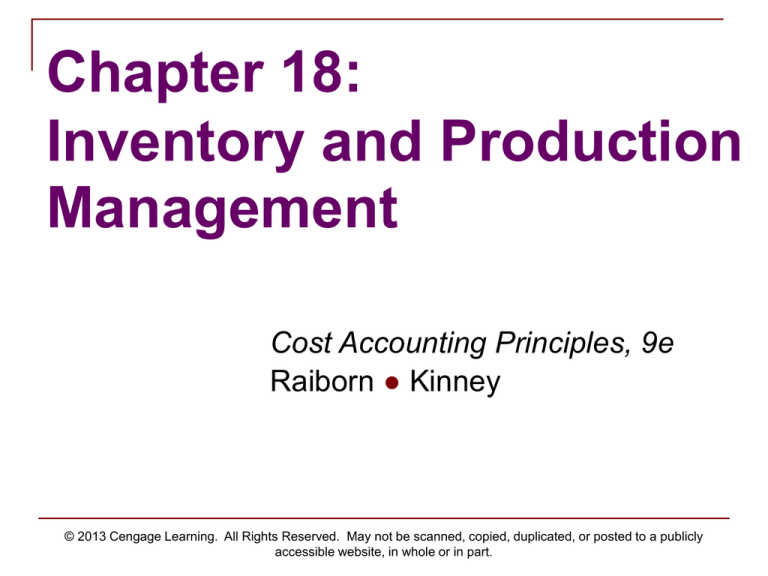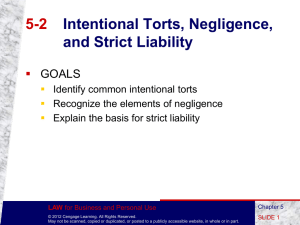
Chapter 18:
Inventory and Production
Management
Cost Accounting Principles, 9e
Raiborn ● Kinney
© 2013 Cengage Learning. All Rights Reserved. May not be scanned, copied, duplicated, or posted to a publicly
accessible website, in whole or in part.
Learning Objectives
What value chain relationships are important to organizations?
What costs are associated with buying, producing, and carrying
inventory?
How do push and pull systems control production?
Why do product life cycles affect profitability?
What is target costing, and how does it influence production cost
management?
What is the just-in-time philosophy and what modifications does JIT
require in accounting systems?
What are flexible manufacturing systems?
Why are lean enterprises important in today’s business environment?
How can the theory of constraints help in determining production flow?
(Appendix) How are economic order quantity, order point, and safety
stock determined and used?
© 2013 Cengage Learning. All Rights Reserved. May not be scanned, copied, duplicated, or posted to a publicly
accessible website, in whole or in part.
Inventory Items
Inventory is often a firm’s largest investment
Merchandise for resale
Manufacturing raw materials, work-inprocess and finished goods
Firms today should minimize inventory while
meeting customer demands
© 2013 Cengage Learning. All Rights Reserved. May not be scanned, copied, duplicated, or posted to a publicly
accessible website, in whole or in part.
Value Chain
Customers and Suppliers
may be internal or external
Suppliers
Production plants
Finished goods
Distribution centers
Customers
© 2013 Cengage Learning. All Rights Reserved. May not be scanned, copied, duplicated, or posted to a publicly
accessible website, in whole or in part.
Production Systems
Push Systems
Produce in anticipation of customer orders
Store raw material, work in process, and
finished goods inventory
Pull
Produce as needed
Minimal storage
© 2013 Cengage Learning. All Rights Reserved. May not be scanned, copied, duplicated, or posted to a publicly
accessible website, in whole or in part.
Product Life Cycles
S
A
L
E
S
TIME
Development
Stage
© 2013 Cengage Learning. All Rights Reserved. May not be scanned, copied, duplicated, or posted to a publicly
accessible website, in whole or in part.
Introduction Stage
Substantial costs including engineering
changes, market research, advertising,
and promotion
Sales price matches similar or Introduction
Stage
substitute goods
Sales low
S
A
L
E
S
TIME
© 2013 Cengage Learning. All Rights Reserved. May not be scanned, copied, duplicated, or posted to a publicly
accessible website, in whole or in part.
Growth Stage
Increased sales
Quality may improve
Prices stable
Growth
Stage
S
A
L
E
S
TIME
© 2013 Cengage Learning. All Rights Reserved. May not be scanned, copied, duplicated, or posted to a publicly
accessible website, in whole or in part.
Maturity Stage
Sales stabilize or decline slowly
Firms compete on selling price
Costs at lowest level
Maturity
Stage
S
A
L
E
S
TIME
© 2013 Cengage Learning. All Rights Reserved. May not be scanned, copied, duplicated, or posted to a publicly
accessible website, in whole or in part.
Decline Stage
Waning sales
Dramatic price cuts
Cost per unit increases as
fixed costs are spread
over fewer units
Decline
Stage
S
A
L
E
S
TIME
© 2013 Cengage Learning. All Rights Reserved. May not be scanned, copied, duplicated, or posted to a publicly
accessible website, in whole or in part.
Just-in-Time
Eliminate any process or operation
that does not add value
Continuous improvement in
production/performance efficiency
Reduction in total cost of
production/performance while
increasing quality
© 2013 Cengage Learning. All Rights Reserved. May not be scanned, copied, duplicated, or posted to a publicly
accessible website, in whole or in part.
Traditional Manufacturing
Smooth operating activity
steady use of workforce
continuous machine utilization
Spread overhead over a maximum
number of products
Inventory levels high enough to cover up
inefficiencies in acquisition and/or
production
© 2013 Cengage Learning. All Rights Reserved. May not be scanned, copied, duplicated, or posted to a publicly
accessible website, in whole or in part.
JIT Plants
Minimize material handling time, lead time,
movement of goods
Use manufacturing cells which allow for
visual controls, greater teamwork, quick
exchange of vital information
Reduce storage
Increase throughput
Develop multiskilled workers
Use automation—programmed factory
equipment
© 2013 Cengage Learning. All Rights Reserved. May not be scanned, copied, duplicated, or posted to a publicly
accessible website, in whole or in part.
Manufacturing Methods
Flexible Manufacturing
System (FMS)
Network of robots and
material conveyance
devices monitored and
controlled by computers
Modular factories
Customization
Quick, inexpensive
production changes
Computer-Integrated
Manufacturing (CIM)
Two or more FMSs
connected via host
computer and
information system
© 2013 Cengage Learning. All Rights Reserved. May not be scanned, copied, duplicated, or posted to a publicly
accessible website, in whole or in part.
Theory of Constraints (TOC)
Flow of goods through a production
process cannot be at a faster rate than
the slowest bottleneck in the process
Eliyahu Goldratt and Jeff Cox
© 2013 Cengage Learning. All Rights Reserved. May not be scanned, copied, duplicated, or posted to a publicly
accessible website, in whole or in part.
Constraints
Constraint—anything that confines or limits
the ability of a person or machine to
perform a project or function
Human constraints
Material constraints
Machine constraints
Place quality control points before
bottlenecks
© 2013 Cengage Learning. All Rights Reserved. May not be scanned, copied, duplicated, or posted to a publicly
accessible website, in whole or in part.
Questions
What is the difference between push
and pull systems of production?
What is target costing?
What is the just-in-time philosophy?
How does JIT affect production?
© 2013 Cengage Learning. All Rights Reserved. May not be scanned, copied, duplicated, or posted to a publicly
accessible website, in whole or in part.
Potential Ethical Issues
Producing inventory not needed driven by
achieving operating profits
Avoiding innovative production and inventory
driven by avoiding short-run costs
Blaming suppliers for inventory mistakes
caused by management
Failure to write down obsolete or spoiled
inventory in a timely manner
Using coercion to force supplies to give price
concessions
Using the adoption of emerging production and
inventory methods to fire workers
© 2013 Cengage Learning. All Rights Reserved. May not be scanned, copied, duplicated, or posted to a publicly
accessible website, in whole or in part.







